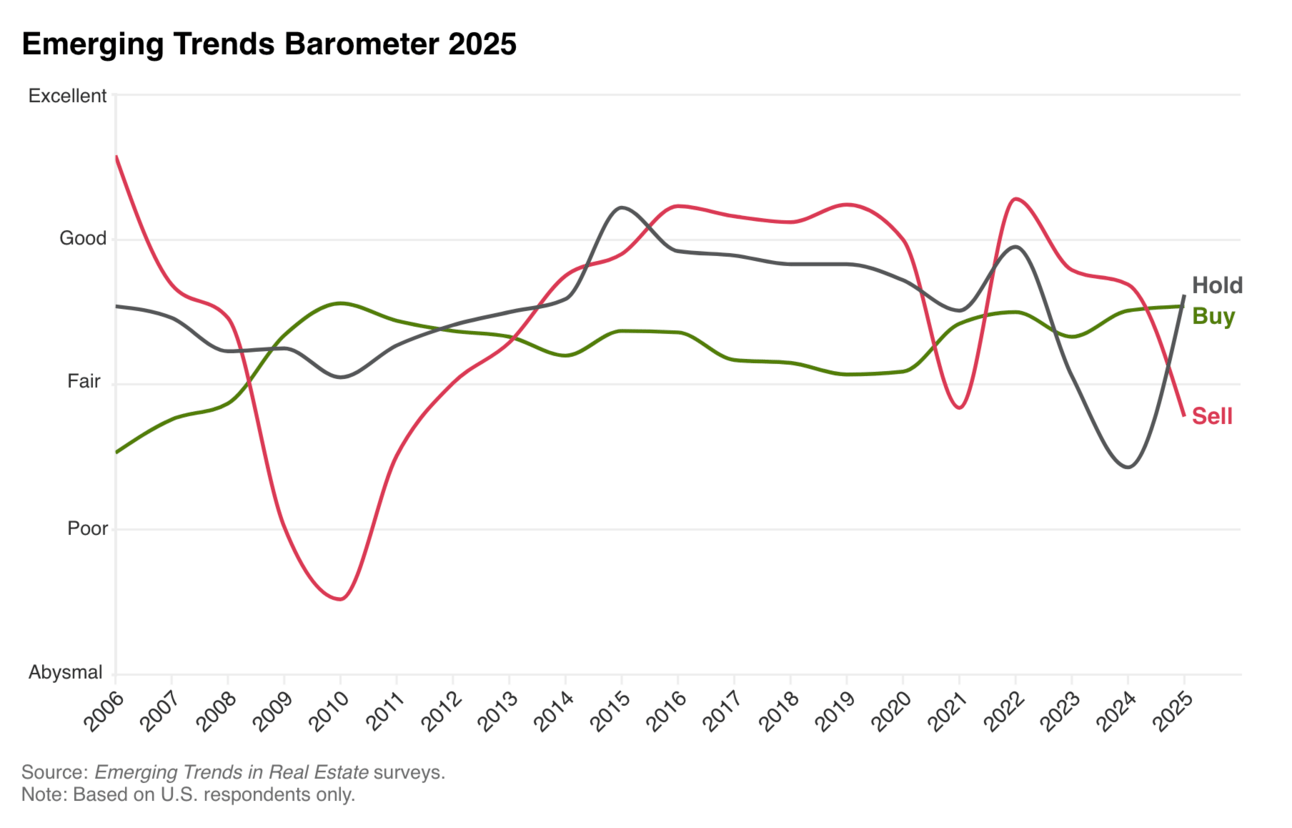We appreciate each and every one of you for taking the time to read Market Minds. Buckle up and enjoy the free value, and you won’t want to miss the 70,000 SQUARE FOOT Utah house with 100 photos that make you want to say “what the ****?…”
The Fed Cracks the Ice, and Capital Markets Stir

Source: Realtor.com
Rate Cuts Are Not Just Math, They’re Permission
The Federal Reserve’s September pivot was more than a 50-basis-point adjustment. It was a narrative shift — a clear signal that the era of aggressive tightening is officially in the rearview. Investors had been bracing for a prolonged rate plateau. Instead, they got a green light. Another 150 basis points in projected cuts over the next 18 months suggests that monetary policy will actively support a return to deal flow, not just stabilize the macro backdrop.
More importantly, it restores clarity. Sellers, who spent the past 18 months clinging to 2021 valuations, now face market consensus on future capital costs. Buyers, no longer pricing in daily uncertainty, are once again willing to do the work. Bid-ask spreads are compressing not because of euphoria, but because both sides now have a shared language: forward-looking yields under a normalized rate regime.
Liquidity Isn’t Rushing Back. It’s Seeping In.
Expectations for firm-level profitability have spiked by 20 points year-over-year, not because fundamentals have changed dramatically, but because pessimism is no longer in charge. There’s enough rate relief to make refinancings possible, and just enough transaction volume to make appraisals defensible.
This is not 2011. Capital is more selective, underwriting is tighter, and leverage is back to being a privilege rather than an assumption. But the paralysis of 2023 — the endless wait for rate stabilization, the seller denial, the lender pullback — is breaking. The ice has cracked. The question is not when to act. It’s how early you’re willing to move while the rest of the market is still negotiating with its own fear.
The Market Has Turned, But It’s a Slow Rotation

Source: Unsplash
The Shift From Structural Disruption to Cyclical Recalibration
2024 marked a turning point. Not in asset values or transaction velocity (those were lagging indicators). The real pivot was psychological. Market participants stopped waiting for a return to pre-pandemic dynamics and began building around the conditions that actually exist.
Remote work patterns have settled. E-commerce penetration has stabilized. And demographic demand drivers have returned to the foreground. This isn’t a market driven by reactive fear. It’s one now shaped by ordinary economic forces: supply, absorption, debt cost, and income growth.
New Supply Is the Silent Stressor
Tenant demand has recovered across many sectors. But in markets where development pipelines remained active throughout the downturn, vacancy pressures are mounting. Industrial, multifamily, and even niche hospitality assets are facing what amounts to a delayed oversupply shock. Leasing activity is strong, but not fast enough to offset aggressive delivery schedules.
At the same time, lower interest rates are arriving just as operating income growth begins to soften. This makes refinancing more viable but less attractive. For well-capitalized owners, this presents a margin squeeze. For leveraged ones, it poses real risk. Value creation in this environment will come not from riding rising tides but from strategic holds, creative restructurings, and a surgical approach to capital stack management.
2025 Will Be Measured by Timing and Discipline
Expect the first half of the year to remain uneven. But as rate cuts accumulate and debt markets regain comfort, transaction volume will accelerate. Not because pricing will soar, but because uncertainty will recede. Strategic capital is already underwriting assets with a 2026–2027 thesis. That’s where opportunity resides — not in hoping for a quick rebound, but in planning for a durable one.
What the Smartest Capital Is Targeting Next

Source: Unsplash
AI Infrastructure Has Quietly Become a Real Estate Thesis
The real estate implications of generative AI are not theoretical. They are spatial, electrical, and deeply physical. The acceleration of AI adoption has created an insatiable need for data processing, and that demand is now outstripping available data center capacity in major metros.
This is not a traditional tech wave that lightly brushes the real estate sector. It is a structural shift in land use value. Data center developers are facing acute constraints: power availability, entitlement risk, and a shortage of zoned land near fiber-rich corridors. Investors who can solve even one of those constraints are capturing meaningful alpha.
Data center REITs are already trading at a premium. But the real opportunity lies in ground-up development and repositioning. Formerly obsolete industrial or flex assets are now being reevaluated not for tenants, but for kilowatt capacity. This asset class is entering a phase of institutionalization, and those who understand the permitting-to-power equation will be writing the next chapter of core-plus.
Office Pricing Is Finally Recalibrating
The office sector is not “back,” but it is beginning to settle into a clearer valuation regime. The worst-case assumptions are being priced in. That alone opens the door for re-entry. Buyers are no longer simply betting on recovery; they are underwriting repositioning strategies with long-term optionality.
This is not a play for trophy assets or gateway markets alone. The most attractive risk-adjusted opportunities may be in high-density urban submarkets where pricing has overcorrected. These are not distressed assets in the classical sense. They are mispriced assets in a recalibrated sector.
Repricing Doesn’t Mean Recovery
The re-emergence of deal activity in 2025 will not come from cap rate compression. It will come from greater confidence in underwriting exit scenarios. That’s the quiet revolution underway: not a return to frothy pricing, but the return of disciplined underwriting that no longer needs to guess where the floor is.
The Beaver House
This Hyrum, UT home priced at $34.5M is deceiving from the outside, because almost every photo makes you want to say “what the ****?…”
See if you can find the one photo we’re talking about…
Check it out 👇
TL;DR (Too Long; Didn’t Read)
The market’s long freeze is beginning to thaw — not with a flood, but with a quiet seep of capital and confidence. The Fed’s clear signal on future rate cuts has replaced paralysis with shared expectations, allowing buyers and sellers to meet in a more rational pricing environment. While liquidity remains cautious and selective, strategic investors are shifting from waiting to acting, especially in sectors like data infrastructure and recalibrated office markets where clarity has returned, even if growth hasn’t. In 2025, the edge won’t go to those hoping for a rebound, but to those planning around today’s fundamentals with discipline, timing, and tactical repositioning.
Have a great weekend - we’ll see you next Saturday.
Cheers 🍻
-Market Minds Team


